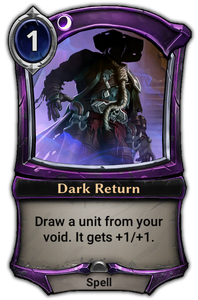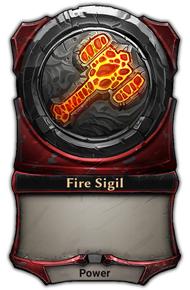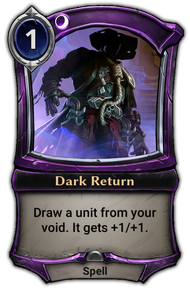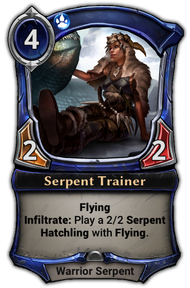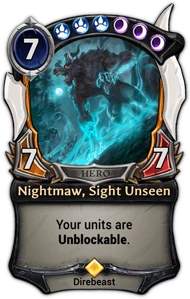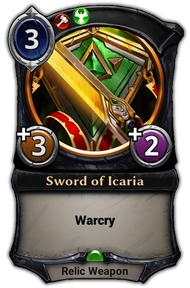m (correcting for Card Set page name capitalization) |
m (WIP. Editing pass-through & update. Added new sections. WIll continue later.) |
||
| Line 1: | Line 1: | ||
| + | '''''Editor's Note:''' This page is in the process of being updated. Some sections may be incomplete at this time. The current editor plans on continuing soon. If this [{{fullurl:{{FULLPAGENAME}} action=history}} page's history] indicates that more than a few days have passed since the last edit, please try contacting the editor or a wiki admin.'' |
||
| − | <p style="font-weight:normal;">Eternal will be starting with over 400 cards total and Dire Wolf Digital has plans to add more cards with expansions and smaller releases in between.</p> |
||
| + | ---- |
||
| − | <p style="font-weight:normal;">When players sign up to Eternal, they start with a free basic set of cards they can build their deck from. New cards can be collected by playing; you can win cards, packs and various other things without any extra cost. </p> |
||
| + | {{TocRight}} |
||
| ⚫ | |||
| + | ''Eternal'' is played using decks of cards which represent the game's various units, spells, and equipment. [[Dire Wolf Digital]] launched ''Eternal'' with over 400 cards and has added more with expansions and smaller releases in between. |
||
| + | New players start with a free basic set of cards which they can use to build their [[Cards#Deck|deck]]. New cards can be purchased, at random in [[Cards#Packs|packs]] or in pre-set [[Cards#Campaigns]]. They may be [[Cards#Crafting|crafted]], swapping excess or unwanted cards to create unowned ones. Cards are also collected by playing — you can win cards, packs and various other things without any extra cost. |
||
| − | *[[Power]] |
||
| + | |||
| − | *[[Units]] |
||
| + | == Card Types == |
||
| − | *[[:Category:Spell|Spells]] |
||
| ⚫ | |||
| − | *[[:Category:Relic|Relics]] |
||
| + | |||
| − | *[[:Category:Weapon|Weapons]] |
||
| + | === Power === |
||
| − | Complete list of all the cards added into the Wiki can be found from under each card type or in [[:Category:Card]]. |
||
| + | {{Main|Power}} |
||
| + | '''Power Cards''' provide the two main resources in ''Eternal'' used to play the other card types: [[Power]] and [[Influence]]. All other cards have Power cost and Influence costs which restrict when they can be played. |
||
| + | |||
| + | === Units === |
||
| + | {{Main|Units}} |
||
| + | '''Unit Cards''' represent the [[Hero]]es, denizens, and creatures of ''Eternal''. Units are used to fight players and each other in combat. Units remain on the play area until killed, at which time they are placed in the player's discard zone called [[the Void]]. |
||
| + | |||
| + | === Spells === |
||
| + | {{Main|Spells}} |
||
| + | '''Spell Cards''' |
||
| + | |||
| + | === Relics === |
||
| + | {{Main|Relics}} |
||
| + | '''Relic Cards''' |
||
| + | |||
| + | === Weapons === |
||
| + | {{Main|Weapons}} |
||
| + | '''Weapon Cards''' |
||
| + | |||
| + | A complete list of all the card type, sub-type, and card pages added to the Wiki can be found in the [[:Category:Card|''Card'' category page]]. |
||
| + | |||
| + | <small>'''Note:''' Wiki editors may use this [[Project:Card Lists|list of cards]] to assist in card page creation.</small> |
||
==Card Explanation== |
==Card Explanation== |
||
| + | All the cards in Eternal are laid out in similar manner. |
||
{{Card3|Fire Sigil|Dark Return|Serpent Trainer}} |
{{Card3|Fire Sigil|Dark Return|Serpent Trainer}} |
||
| − | + | The above examples show different cards from the simplest form ({{CardHover|Fire Sigil}} on the left side) to more complicated ({{CardHover|Dark Return}} spell and {{CardHover|Serpent Trainer}} unit on the right). |
|
The top and majority of the area is occupied by an image giving the card flavor and recognizability and right below it is the card's name. At the very bottom, written with small print, is the type or subclass of the card. All cards have these and their edges also show which influence they are related to (note: also multiple factions or no factions are also possible). |
The top and majority of the area is occupied by an image giving the card flavor and recognizability and right below it is the card's name. At the very bottom, written with small print, is the type or subclass of the card. All cards have these and their edges also show which influence they are related to (note: also multiple factions or no factions are also possible). |
||
| Line 37: | Line 61: | ||
{{CardHover|Sword of Icaria}} |
{{CardHover|Sword of Icaria}} |
||
) have a plus sign in front of the number which tells respectively how much both the damage and the health of a Unit are increased. With Relic Weapons, the lower right modifier denotes an amount of armor that will be added to your Avatar, which is consumed (and the Relic Weapon destroyed) before further attacks start affecting your Avatar's health again. Spells and effects that add armor to your Avatar will extend the "life" of your Relic Weapon. |
) have a plus sign in front of the number which tells respectively how much both the damage and the health of a Unit are increased. With Relic Weapons, the lower right modifier denotes an amount of armor that will be added to your Avatar, which is consumed (and the Relic Weapon destroyed) before further attacks start affecting your Avatar's health again. Spells and effects that add armor to your Avatar will extend the "life" of your Relic Weapon. |
||
| + | |||
| + | == Premium Cards == |
||
== Card Set == |
== Card Set == |
||
| Line 55: | Line 81: | ||
When building your deck, you can add any combination of the five influences in your deck. Avatars don't restrict or affect the deck building in any way. |
When building your deck, you can add any combination of the five influences in your deck. Avatars don't restrict or affect the deck building in any way. |
||
| + | |||
| + | == Obtaining Cards == |
||
| + | === Packs === |
||
| + | === Crafting === |
||
| + | === Campaigns === |
||
| + | === Promotional Quests === |
||
| + | |||
| + | == Card Backs == |
||
[[Category:Mechanics]] |
[[Category:Mechanics]] |
||
Revision as of 21:32, 12 May 2018
Editor's Note: This page is in the process of being updated. Some sections may be incomplete at this time. The current editor plans on continuing soon. If this page's history indicates that more than a few days have passed since the last edit, please try contacting the editor or a wiki admin.
Eternal is played using decks of cards which represent the game's various units, spells, and equipment. Dire Wolf Digital launched Eternal with over 400 cards and has added more with expansions and smaller releases in between.
New players start with a free basic set of cards which they can use to build their deck. New cards can be purchased, at random in packs or in pre-set Cards#Campaigns. They may be crafted, swapping excess or unwanted cards to create unowned ones. Cards are also collected by playing — you can win cards, packs and various other things without any extra cost.
Card Types
There are five main types of cards in Eternal:
Power
- Main article: Power
Power Cards provide the two main resources in Eternal used to play the other card types: Power and Influence. All other cards have Power cost and Influence costs which restrict when they can be played.
Units
- Main article: Units
Unit Cards represent the Heroes, denizens, and creatures of Eternal. Units are used to fight players and each other in combat. Units remain on the play area until killed, at which time they are placed in the player's discard zone called the Void.
Spells
- Main article: Spells
Spell Cards
Relics
- Main article: Relics
Relic Cards
Weapons
- Main article: Weapons
Weapon Cards
A complete list of all the card type, sub-type, and card pages added to the Wiki can be found in the Card category page.
Note: Wiki editors may use this list of cards to assist in card page creation.
Card Explanation
All the cards in Eternal are laid out in similar manner.
The above examples show different cards from the simplest form (Fire Sigil on the left side) to more complicated (Dark Return spell and Serpent Trainer unit on the right).
The top and majority of the area is occupied by an image giving the card flavor and recognizability and right below it is the card's name. At the very bottom, written with small print, is the type or subclass of the card. All cards have these and their edges also show which influence they are related to (note: also multiple factions or no factions are also possible).
Most of the cards (excluding basic Sigils and other Power cards) have their requirements printed at the top left corner of the card: The number denotes the required Power while the number of smaller symbols tells how much Influence is required in order to play the card. For example,
Serpent Trainer
requires player to use 4 Power and have at least one influence in ![]() Primal.
Primal.
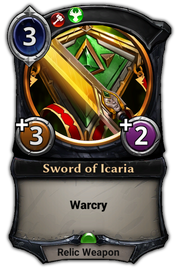
A +3/+2 Relic Weapon.
Some cards have additional description of their abilities and effects written on the bottom of the front face.
Serpent Trainer has both an ability and an effect: Abilities are usually single, bolded words (like Flying) while Effects list a triggering condition (like Infiltrate) and a description of what happens after the requirements are met. Some Units have effects that are always on when the card is played and therefore don't list any triggering condition (e.g.
Nightmaw, Sight Unseen 's "Your units are Unblockable" gives all other friendly units Unblockable ability).
Dark Return on the other hand is a spell and the description lists the single use effects it has when the card is played. Weapons have similar effects that add abilities and effects to Units. Finally, some cards (namely Units and Weapons) have numbers printed on the bottom corners of the image. With Units, the left number tells how much damage they are able to inflict in a single blow. The right one is the amount of health the Unit has. The weapons (like
Sword of Icaria ) have a plus sign in front of the number which tells respectively how much both the damage and the health of a Unit are increased. With Relic Weapons, the lower right modifier denotes an amount of armor that will be added to your Avatar, which is consumed (and the Relic Weapon destroyed) before further attacks start affecting your Avatar's health again. Spells and effects that add armor to your Avatar will extend the "life" of your Relic Weapon.
Premium Cards
Card Set
- Main article: Card set
Cards are divided between several card sets in Eternal. Current card sets include The Empty Throne [Set1], Jekk's Bounty [Set1001], Omens of the Past [Set2], The Tale of Horus Traver [Set1002], The Dusk Road [Set3].
Sets are card expansions which comes in packs. Each pack gives 15 cards, being 11 commons, 3 uncommons, and one rare or better.
Campaigns are card expansions that have to be bought all together at once and give a comparatively small number of cards, and you unlock cards by beating the missions in the campaign. The tutorial is a campaign given out for free to all players.
Upon completing the campaign missions for each of the 5 single factions, players are awarded with a starter deck that consists of 45-50 cards from that faction. More cards can be acquired through Gauntlet, Forge, Ranked modes, Puzzles, opening the corresponding card packs, playing through the adventures Jekk's Bounty and The Tale of Horus Traver, as well as through crafting.
For more information on card sets and a list of all card sets, see the main article: Card Sets.
Deck
Players build decks from the cards they've collected. The minimum deck size is 75 cards with the maximum number of copies of a single card being 4. The maximum deck size is very high, around 250, however closer to the minimum of 75 cards is recommended for deck consistency. At least one third of the deck must be made up of Power cards.
When building your deck, you can add any combination of the five influences in your deck. Avatars don't restrict or affect the deck building in any way.


